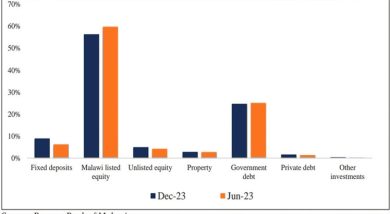Businesses, consumers rue high interest rates
Businesses and consumers have lamented commercial banks’ move to raise base lending rates to 22.7 percent, saying it will slow consumption and investment in the country.
The reaction follows the 1.3 percentage points raise in the lending rate from 21.4 percent to 22.7 percent due to the hike in the Reserve Bank of Malawi (RBM) policy rate from 22 percent to 24 percent.
According to published statements from banks, the raise in reference rate, an interest rate benchmark used to set other interest rates, means that borrowers will now be paying between 22.7 percent and 34 percent for loans.

Speaking in an interview on Thursday, Indigenous Businesses Association of Malawi president Mike Mlombwa said with an already difficult operating environment, the hike in interest rates is retrogressive to the development of businesses, particularly small-scale ventures.
He said: “SMEs are already struggling from the negative impacts of Covid, cyclones and low international investments. Already, we find difficulties to access loans.
“It is bad news for small businesses at a time we thought we would start growing again. So, it’s worrisome to SMEs.”
Consumers Association of Malawi executive director John Kapito bemoaned the development, observing that interest rates continue to bite consumers who are currently struggling to service loans and borrow more to expand their businesses.
“Our huge fear and concern as consumers is that the hike in interest rates will continue to affect productivity as industries will not borrow, which will shrink industrial activity and hurt ordinary Malawians,” he said.
Chamber for Small and Medium Businesses Association executive secretary James Chiutsi said increasing the cost of borrowing will dampen small businesses’ growth prospects.
“Access to finance will be limited and small and medium enterprises will be forced to raise prices of their products, leading to slower business growth,” he said.
Meanwhile, commercial banks’ published financial statements for the year ended December 2022 show that non-performing loans have been on the rise due to growth in the customer loan book, resulting in credit impairments.





